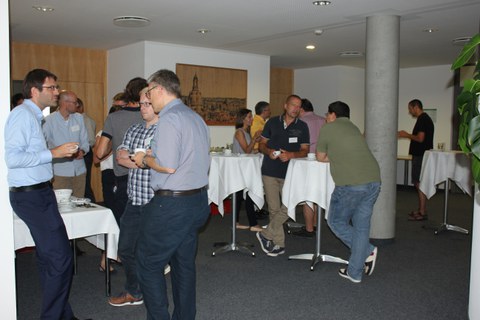Aug 29, 2019
Saxon researchers convene at 2nd Leipzig-Dresden-BioScience Meeting

Bioscientists from Leipzig and Dresden in lively exchange at the 2nd Leipzig-Dresdner-BioScience Meeting in August 2019
On August 29-30th, 2019, 25 biomedical researchers from various disciplines of the universities Leipzig and Dresden met for the 2nd BioScience Meeting, which had the focus to get to know each other better and to exchange ideas on future joint research topics.
Already for several years, clinicians and basic researchers of the University Hospitals Leipzig and Dresden have been successfully working closely together on various cooperative projects in the field of metabolic diseases, and diabetes in particular. These include, for example, joint participation in clinical studies on type-2 and type-1 diabetes centrally coordinated by the German Center for Diabetes Research (DZD) or joint projects for the investigation of fat tissue inflammation and insulin resistance. However, the two sites are also working closely together in the field of liver research in order to investigate, for example, the multidimensional genomic signature during liver growth and the development of liver hypertrophies.
"Leipzig and Dresden have an innovative, young and dynamic life science campus in the direct vicinity of the respective university hospital" says Ünal Coskun, head of the research group for membrane biochemistry at the Paul Langerhans Institute Dresden and one of the two initiators of the meeting. "We want to cooperate more closely in different areas and at this 2nd BioScience Meeting we want to look for new joint research fields for sustainable collaborations. In our opinion, this is the basic prerequisite for the long-term synergistic integration of biomedical research in Saxony," he added.
Already during the 1st Leipzig-Dresden BioScience Meeting in February 2019, initial contacts were made and various potential project ideas were discussed. "Our colleagues in Dresden, for example, have an outstanding expertise in investigating lipids, which fundamentally determine the signal behavior of receptors and other membrane-bound actuators of biological signal paths. In Leipzig, on the other hand, we have a whole range of top-class measurement methods and models to offer that are excellently suited to better understand the biological context of lipid-associated signal phenomena," says Tobias Langenhan, Professor of General Biochemistry and Organ Biochemistry at the Rudolf Schönheimer Institute of Biochemistry at the University of Leipzig and co-initiator of the meeting.
In the opinion of the initiators, both locations can profit sustainably from each other through closer cooperation. This forum, which from now on should enable a regular scientific exchange, is an important component.
